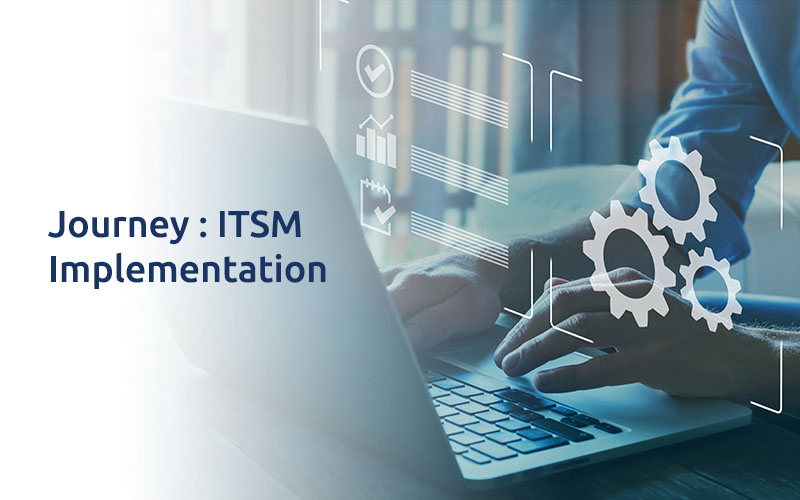Journey: ITSM Implementation
Imagine you're processing an offer for a contract when the internet suddenly goes off or your computer randomly shuts down. It's annoying. Avoiding this situation altogether, or at least minimizing its impact, requires a well-thought-out ITSM (IT Service Management) strategy.
But that is easier said than done!
IT Service Management: ITSM
ITSM is the set of processes used to design, implement and deliver IT services. Ideally, it creates the right mix of people, technology and practices to ensure a smooth and efficient process.
Different ITSM tools serve different purposes to meet different business needs. Some tools focus on ticketing, while others offer broader capabilities for identifying and remediating the root cause of negative incidents.
When talking about ITSM, don't forget ITIL, which has become an acronym for IT Infrastructure Library. ITIL is one of the most widely used frameworks for ITSM implementations. It provides general guidelines and is not related to any specific area. Organizations typically choose and implement policies based on their needs.
The most commonly used ITIL practices are incident, problem and change management.
Incident Management
This practice deals with everyday occurrences. It can happen at any hierarchy level within the company (for example, if a new employee doesn't have access to her CRM tool).
To manage incidents, agents create tickets and support teams handle issues. Ticketing is more efficient than other methods. It helps you prioritize issues, collect all incidents in one place for review and analysis, and track incident history.
Problem Management
This practice is aimed at identifying and solving more complex problems. If you see many incidents related to the same problem, they may all have one common cause. If all your new hires have the same problem when signing up for your CRM tool, it means your signup process isn't set up properly. Problem management takes care of that.
Change Management
Change management involves evaluating ongoing processes and current technology to maximize business value. This ensures that your IT services are stable and reliable, and can adapt quickly to your business needs.
Challenges for ITSM Implementation
ITSM is a complex process, It can cause problems in various sprints;
Tech Challenges:
Automation: When IT departments spend most of their time setting up employee accounts, they don't have time to deal with more complex IT issues. To free up your IT team, you need to automate routine tasks.
Integration: A successful system integration ensures that half of your data is not lost when moving from the old system to the new. If your legacy and new systems are incompatible, you're putting your data at great risk.
People Challenges:
- Lack of feedback from IT specialists and employees
- Bad or missing communication channels between participants
- Resistance to change
- Inaccurate knowledge of ITSM or its purpose
- Inadequate training of professionals implementing ITSM
Process Challenges:
- Lack of documentation and inadequate ITSM implementation procedures
- Undefined goals and metrics for implementation
- Problem highlighting and resolution failed
- Partial implementation of the process
Process challenges stem from poor planning and execution. Define measurable goals and monitor the entire process to avoid confusion.
Maintenance Costs:
Implementing ITSM becomes more complex when the tools are too expensive or underfunded. Delays while waiting for funding or completion of any part of the process may affect final results.
Best Practices for ITSM Implementation:
Evaluate your Capabilities:
To properly measure your abilities, start with an assessment of your current state. Evaluate the resources you can devote to implementing ITSM. Be aware of current issues (old software, internal communication barriers, etc.).
Identify areas where your service management strategy is not running at optimal productivity. After conducting the assessment, set priorities and decide which issues require immediate attention and which can wait.
Automation: Tasks and Designs:
Automation allows IT to spend less time solving mundane tasks that employees can solve on their own. Clear instructions and well-labeled button clicks can be less of a problem. Automation creates self-sufficiency through self-service. This means end users can quickly resolve everyday issues individually. Self-service works by combining knowledge base information with her existing ITSM tools.
Metric Defined Goals:
By defining metrics to track, you can identify areas for improvement. Measure progress against goals across categories such as cost, employee satisfaction, self-service usage, and IT response time. Tracking your progress in these categories will let you know if ITSM is right for you.
Data Migration:
Importing data into new systems is an inevitable part of ITSM adoption. Additionally, data migration often comes with its own set of challenges, including: Examples include unproven technology, poor preparation, inadequate software, and lack of expertise and planning. Make sure your data is transferred correctly and that your new platform is easy to use. Implementing or changing an ITSM tool is a complex process that requires thorough preparation. There are many people involved, and everyone needs to be informed, educated, and trained throughout the ITSM implementation process. Allow sufficient preparation time for a smooth ITSM implementation. From defining ITSM goals to implementing best practices, make sure you've covered all the bases before you start.
Platform Selection:
The Final and the most important part is selecting the platform that will suffice all your needs.
To know more about Platforms, ITSM and IT Transformation you can reach us at [email protected] or fill our contact us form!
